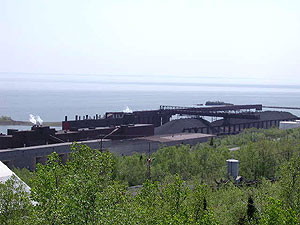|
Audio
Photos
Respond to this story
|
A new kind of iron ore
June 2, 2003
 |
| Mesabi Nugget is making high-grade iron ore in the old research building at North Shore Mining in Silver Bay. (MPR Photo/Stephanie Hemphill) |
Silver Bay, Minn. — Larry Lehtinen grew up on Minnesota's Iron Range. All his life he worked in mines that turned low-grade iron ore into taconite pellets. Huge blast furnaces in Pittsburgh and Cleveland turned the pellets into steel.
Those big steel mills are old now, and inefficient. They can't compete with newer mills being built around the world. American steel companies, and the mines that supply them with ore, are scrambling to adjust. Some are going bankrupt. Larry Lehtinen saw it coming.
"All the dynamics that have led to the rapidly changing industry were very clear to me back in the late 80s," he says. "This is something that I was predicting a long long time ago."
 | |||
Lehtinen decided he wanted to create a product that offered a better future for the Iron Range. He went to Indiana, where he helped set up a plant that produced direct-reduced iron. That's an iron pellet that has more iron in it than taconite.
Then he heard about a Japanese company, Kobe Steel. The firm had invented a new way of making an even purer product.
"Before going to Japan I was skeptical because it didn't seem like it was really possible," Lehtinen says. "It seemed too good to be true from a metallurgist standpoint. But I was a believer as soon as I saw it back then, and have been pursuing it vigorously since then."
Lehtinen lined up several American companies to cooperate with Kobe Steel to build a test plant in the U.S. The partnership is called Mesabi Nugget. He talked the state of Minnesota into lending $16 million for the equipment. The new company set it up in an unused building at the North Shore taconite plant in Silver Bay.
 | |||
About a week ago they fired it up. The machines are so loud, it's impossible to be heard in a normal voice. The heat is intense.
Machines mix the ore with coal and several other ingredients. Lehtinen won't reveal all of them. The mixture is formed into balls, and run through a furnace that gets hotter than 2500 degrees Fahrenheit. The heat burns off oxygen and other impurities, as the ore melts into pellets the size of small marbles.
 | |||
Technicians watch the process from a control room at one end of the plant. Sensors feed information into their computers. They relay instructions to the machine operators using radios.
Dave Chappie moved his family here from Indiana to make iron nuggets.
"The other day when we run nuggets off this belt, it was almost too good to be true," Chappie says. "We've had a pretty great start-up here with few minor problems."
The first nuggets out of the Silver Bay plant are going to Japan for further testing. As the pilot project continues, the plants will sell it nuggets to a steelmaker in Indiana.
 | |||
The nuggets rolling out of the furnace here are 96% iron. Taconite pellets are only about 65% iron. Larry Lehtinen says the new-style nuggets are so pure, turning them into steel is much better for the environment than the old blast furnaces.
"It's much more efficient, eloquently simple, and consequently a lot cleaner," Lehtinen says, "a much more environmentally friendly way to make iron and steel."
But some environmentalists say it's not clean enough. Jane Reyer is with the National Wildlife Federation. She says it would be better if they could make nuggets using natural gas rather than coal.
"If we're going to be developing new technology at this point, let's find the technologies that are the most environmentally friendly. I don't think that this is the one," she says.
|
"If it's proven on a commercial scale, there's no reason to believe you might not be able to use that at other facilities,"
- Brian Hiti, IRRRA |
People concerned about the economy of northeastern Minnesota are hoping the pilot project will prove the new technology is commercially viable. Brian Hiti is with the Iron Range Resources and Rehabilitation Agency.
"If it's proven on a commercial scale, there's no reason to believe you might not be able to use that at other facilities," Hiti says. "It all depends on the needs of the customer."
The pilot nugget plant in Silver Bay will run for about a year. Larry Lehtinen hopes to start work on the environmental study for a full-scale plant as early as this fall.
|
News Headlines
|
Related Subjects
|
